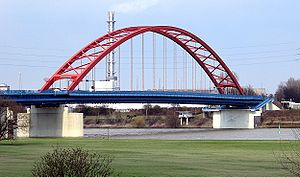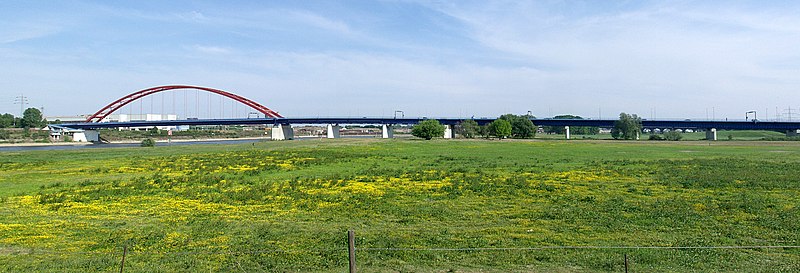Bridge of Solidarity
Coordinates: 51 ° 24 ′ 54 ″ N , 6 ° 44 ′ 19 ″ E
| Bridge of Solidarity | ||
|---|---|---|
| Bridge of Solidarity, view from the south | ||
| Official name | originally: Admiral Graf Spee Bridge since 1988: Bridge of Solidarity |
|
| use | Road bridge | |
| Convicted | Moerser Strasse | |
| Crossing of | Rhine | |
| place | Duisburg | |
| construction | Tied arch bridge | |
| Longest span | 255.9 m | |
| start of building | July 1945 | |
| opening | 3rd July 1950 | |
| location | ||
|
|
||
| Above sea level | 21 m | |
The Bridge of Solidarity is a Rhine bridge between the Duisburg districts of Rheinhausen and Hochfeld at Rhine kilometer 775.29.
Bridge story
Bridge story
The previous bridge , the Admiral-Graf-Spee- Bridge , was built from January 12, 1934 as part of a state employment program and opened to traffic on May 22, 1936 by Reich Propaganda Minister Joseph Goebbels . The construction costs amounted to 6.75 million Reichsmarks . There were tollbooths for the use of the bridge on both sides.
On March 4, 1945 soldiers of the Wehrmacht blew up the Admiral-Graf-Spee-Bridge, the Duisburg-Hochfelder Railway Bridge , the Friedrich-Ebert-Bridge (Duisburg-Ruhrort) and the Krefeld-Uerdinger Bridge in front of the approaching 9th US Army , which had crossed the Rur on February 23 at Linnich, Jülich and Düren and advanced between Neuss and Rheinberg to the Rhine ( Operation Grenade ). The flood bridge on the left bank of the Rhine was not blown up. The Western Allies later crossed the Rhine in other places ( Operation Plunder , Bridge von Remagen ) and surrounded the Ruhr area .
A new road bridge was built from July 1945 and opened to traffic on July 3, 1950. In place of the earlier construction, a tied arch bridge was proposed by Krupp Stahlbau Rheinhausen . It has a span of 255.9 meters and is considered the longest of its kind in Germany .
The earlier bridge had four lanes ; the new one was built with only three lanes on the orders of the British occupation authorities . The middle lane is released for one direction of travel by a light signal. The bridge was expanded in the early 1990s, especially the old parts of the flood bridge on the left bank of the Rhine.
Technical specifications
- Construction type: Langerscher beam
- Span of the arch: 255.91 m
- Arrow height 35.5 m
- Reinforcement beams: single-walled riveted sheet metal beams with a web plate height of 4320 mm
- Distance between stiffening beams: 12.4 m
- Bar height of the hat cross-section: 1.7 m at the top, 2.10 m at the fighter
- Lane width: 9 m (3 lanes of 3 m)
- Usable cycle path width: 1.1 m
- Usable sidewalk width: 1.8 m
Naming
In 1987 Rheinhausen gained nationwide attention through resistance to company plans for a steelworks . On December 10, 1987, Krupp workers occupied the Rhine Bridge to protest against its closure. There were local demonstrations against the project throughout the winter. In addition to the Rhine bridge, a driveway to the federal motorway 40 was temporarily blocked and the iconic Villa Hügel of the Krupp Foundation in Essen was occupied. Month-long vigils accompanied the clashes. Rheinhausen became a symbol of resistance against the steel crisis .
The Rhine Bridge was renamed the Bridge of Solidarity by the workers on January 20, 1988 . On that day, 50,000 steelmakers from over 60 German steelworks moved to the bridge. Youth representatives from the Krupp training workshop had made the new name badge. This name was later officially adopted by the city of Duisburg.
literature
- Waltraud Bierwirth: AufRuhr. Rheinhausen 1987/1997 . Klartext, Essen 1997, ISBN 3-88474-596-4 (photos by Manfred Vollmer).
- Hartwig Untouched: Rhine crossings in the Duisburg area . In: Freundeskreis lively Grafschaft Duisburg (ed.): Yearbook 1988/1989 of the districts of the city of Duisburg on the left bank of the Rhine . ISSN 0931-2137 , p. 84 ff .
- Willy vom Felde: Building bridges . In: Freundeskreis lively Grafschaft (Ed.): Yearbook 1988/89 of the districts on the left bank of the Rhine in the city of Duisburg . 1989, ISSN 0931-2137 , pp. 90 ff .
See also
Web links
- Picture of the earlier Admiral-Graf-Spee-Brücke 1930s (digit.wdr.de)
- Picture of the destroyed Rhine bridge in 1946
- Aerial photo of the Rhine bridge around 1950
- Picture of the Rhine bridge 1962 (digit.wdr.de)
- Entry on the Rheinhausen-Hochfeld bridge in the " KuLaDig " database of the Rhineland Regional Council
- Bridge of Solidarity. In: Structurae
- Description of this sight on the route of industrial culture
- In Memoriam: Hattingen and Rheinhausen 1987/1988. An attempt at a democracy from below , by Ulla Plener , in Utopie Kreativ, 93, 1998, pp. 16-25
Individual evidence
- ↑ Demonstration on the Rheinhausener Rheinbrücke , photo, German Historical Museum
- ↑ Johannes Nitschmann: freedom of movement. 20 years ago 6,000 workers successfully demonstrated for the preservation of their plant. But where has the strength of the trade unions gone today? Fluter , Federal Agency for Civic Education , BpB, 25, Bonn, December 20, 2007
|
The next bridge up the river: Duisburg-Hochfelder railway bridge |
Bridges over the Rhine |
The next bridge down the river: Rheinbrücke Neuenkamp |




